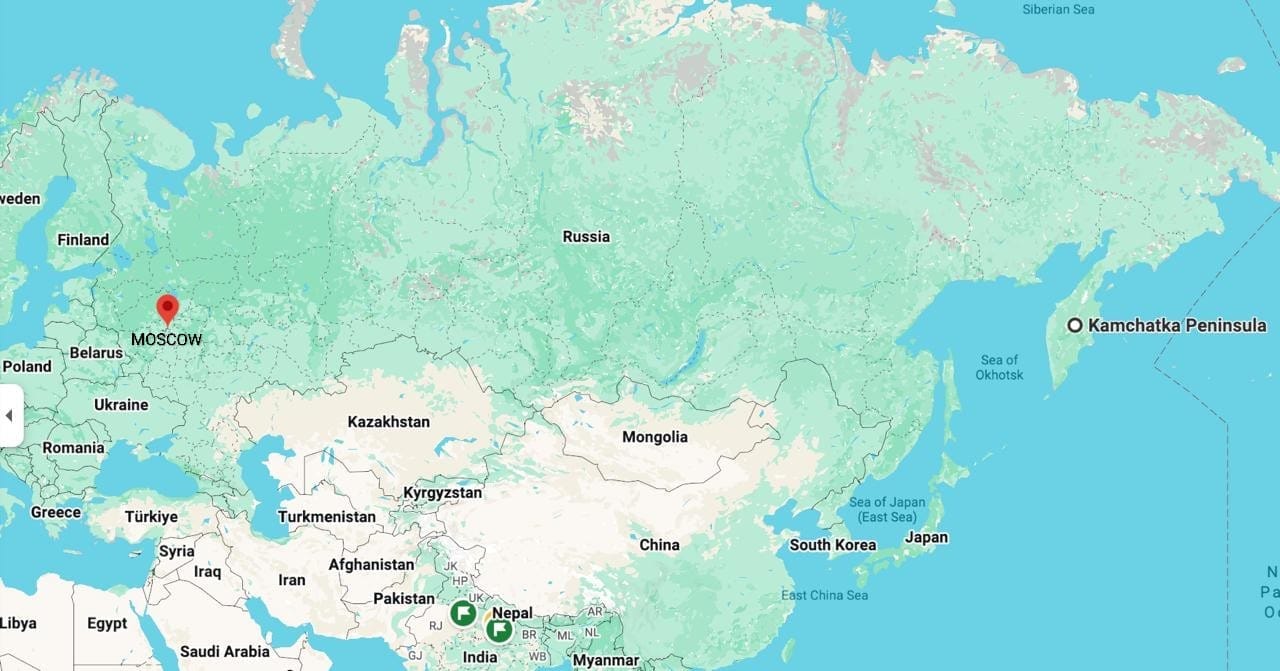
Early Wednesday, Russia woke up to one of the strongest earthquakes ever recorded. Well, not all of Russia. The 8.8 earthquake that struck 119 kilometres from the Russian city of Petropavlovsk-Kamchatsky and triggered several-feet waves along the coasts of the Pacific Ocean, did not have any effect on the Russian capital of Moscow.
Why
Moscow, which lies about 6,800 kilometres from the epicentre of the earthquake, barely felt tremors. Moscow is far from any active tectonic plate boundaries. The Russian capital sits on the stable East European Platform, which is geologically 'quiet' and does not experience the same tectonic pressures.

Moscow is about 6,800 kilometres from the Kamchatka Peninsula. Screengrab: Google Maps
The region of Moscow, in fact, is considered one of the most seismically safe in the world. There's little to no significant earthquake activity ever recorded there. The largest and most damaging of earthquakes that have ever struck Russia have been in other parts. So, an earthquake like the one that just hit the Kamchatka Peninsula does not usually affect Moscow because by the time the tremors reach the region, they lose energy. The seismic waves travel great distances through stable continental crust, far from active faults.
The Kamchatka Peninsula Earthquakes
In contrast, the Kamchatka Peninsula is highly prone to earthquakes because it sits directly on a major tectonic plate boundary. This is the subduction zone where the Pacific Plate is being forced beneath the Okhotsk (part of the North American) Plate at the Kuril-Kamchatka Trench.
This geological setting generates immense pressure over time, which is released as powerful earthquakes and sometimes tsunamis. The boundary is part of the Pacific "Ring of Fire", one of the world's most seismically and volcanically active regions. The Kamchatka region also hosts numerous active volcanoes.
The First Recorded Magnitude 9 Earthquake
The largest recorded earthquakes in Russia in the 20th and 21st Century have mostly been in the Kamchatka Peninsula, with eleven of them being above 8.0 magnitude on the Richter scale, including the one on July 29.
The earthquake that hit the Russian Far East on Wednesday was centred 119 km east-southeast of Petropavlovsk-Kamchatsky. The earthquake was relatively shallow, and struck at a depth of 20.7 kilometre, said the US Geological Survey. It was initially recorded as an 8.0 magnitude earthquake but was revised later. There were also a series of strong aftershocks, in addition to tsunami triggers, after the earthquake.
The July 29 earthquake is tied for the sixth most severe earthquake in history, along with the 2010 earthquake that struck Biobio in Chile, and the 1906 earthquake in Equador's Esmeraldas.
Incidentally, the fifth most severe earthquake ever recorded in history was also in the Kamchatka Peninsula. The 1952 earthquake that struck Kamchatka Krai in Russia was the "world's first recorded magnitude 9 earthquake".
Track Latest News Live on NDTV.com and get news updates from India and around the world

